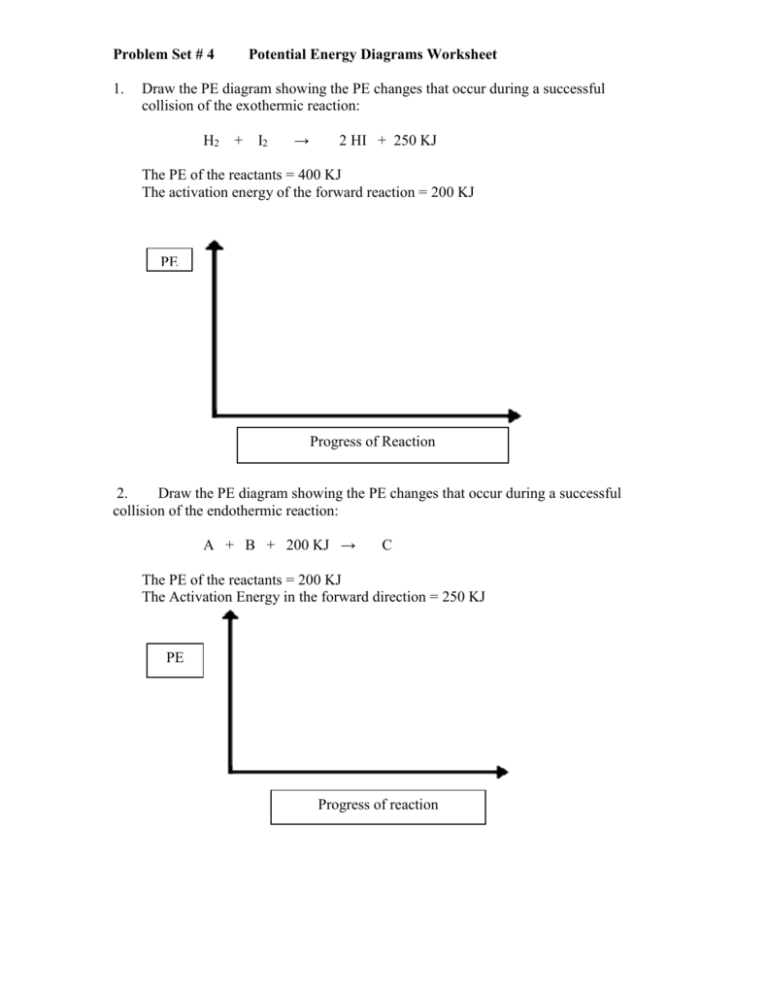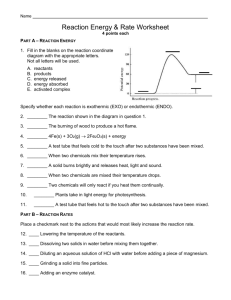File
advertisement

Problem Set # 4 1. Potential Energy Diagrams Worksheet Draw the PE diagram showing the PE changes that occur during a successful collision of the exothermic reaction: H2 + I2 → 2 HI + 250 KJ The PE of the reactants = 400 KJ The activation energy of the forward reaction = 200 KJ PE Progress of Reaction 2. Draw the PE diagram showing the PE changes that occur during a successful collision of the endothermic reaction: A + B + 200 KJ → C The PE of the reactants = 200 KJ The Activation Energy in the forward direction = 250 KJ PE Progress of reaction 3. Draw and label the potential energy diagram for the following reactions. Potential energy of reactants = 250 kJ Potential Energy of activated complex = 350 kJ Potential Energy of the products = 300 kJ a) How does the potential energy change as the reaction proceeds? b) How does the kinetic energy change as the reaction proceeds? c) Is this reaction exothermic or endothermic? d) What is the value of ΔH? If a catalyst was added, what would happen to the energies of the: e) Reactants? f) Products? g) Activated Complex? h) If a catalyst was added what would happen to the rate? 4. Draw and label the potential energy diagram for the following reaction. Potential energy of reactants = 350 kJ Activation Energy = 100 kJ Potential Energy of the products = 250 kJ a) How does the potential energy change as the reaction proceeds? b) How does the kinetic energy change as the reaction proceeds? c) Is the reaction exothermic or endothermic? d) What is the value of ΔH? If the concentration of the reactants was increased, what would happen to the energies of the: e) Reactants? f) Products? g) Activated Complex? h) What would happen to the rate? 5. Draw and label the potential energy diagram for the following reaction. Potential energy of reactants = 200 kJ Potential Energy of activated complex = 400 kJ ΔH = 150 kJ a) How does the potential energy change as the reaction proceeds? b) How does the kinetic energy change as the reaction proceeds? c) Is the reaction exothermic or endothermic? d) What is the value of ΔH? If the temperature was increased, what would happen to the energies of the: e) Reactants? f) Products? g) Activated Complex? h) What would happen to the rate? 6. Draw the potential energy diagram for the following reaction. Potential energy of products = 50 kJ Potential Energy of activated complex = 400 kJ ΔH = -50 kJ a) How does the potential energy change as the reaction proceeds? b) How does the kinetic energy change as the reaction proceeds? c) Is the reaction exothermic or endothermic? d) What is the value of ΔH? If the surface area of the reactants was increased, what would happen to the energies of the: e) Reactants? f) Products? g) Activated Complex? h) What would happen to the rate? 7. What is the only factor, other than changing the reactants involved, which will change the potential energy diagram? Describe how it will affect the diagram and the rate. 12. Label each interval on the potential energy diagram. A B C D E PE Rxn Co-ordinate a) __________________________ b) __________________________ c) __________________________ d) __________________________ e) __________________________ 13. Write the following reaction in ΔH notation. A + B + 200 kJ → C 14. Write the following reaction in Standard Notation. H2 + I2 → 2 HI ΔH = -250 kJ 15. Write in Standard Notation. 2NI3 + 3BaCl2 → 2NCl3 + 3BaI2 ΔH = 175 kJ Problem Set #5 1. Reaction Mechanisms OCl- + H2O HOCl + IHOI + OH- → → → HOCl + OHHOI + ClH2O + OI- i) The net chemical equation is ______________________________________. ii) The reaction intermediates are ___________________________. iii) The catalyst is __________________. 2. Br Br Br2 + OCl2 + Cl → → → 2Br BrOCl BrCl + Cl fast slow fast i) The net chemical equation is ___________________________. ii) The reaction intermediates are __________________________. iii) The catalyst is __________________________. iv) The rate determining step is ___________________. v) If the concentration of Br2 is increased will the rate of the reaction increase? Explain your answer. vi) If the concentration of OCl2 is increased will the rate of the reaction increase? Explain your answer. 3. The mechanism for the catalytic decomposition of formic acid, HCOOH, is shown below. step 1 HCOOH + H+ → [HCOOHH]+ step 2 [HCOOHH]+ step 3 [HCO]+ → → [HCO]+ CO + HOH + H+ The potential energy diagram is: 190 PE 180 170 160 150 Rxn Progress (i) The catalyst is _____________. (ii) The rate determining step is _________________. (iii) ΔH = ____________. (iv) The forward activation energy is ________________. (v) The reverse activation energy is____________. (vi) The enthalpy of [HCOOHH]+ is __________. (vii) Is the reaction exothermic or endothermic? ______________. (viii) Which chemical formula has the greatest potential energy? ____________. (ix) Which chemical formula has the greatest kinetic energy? _______________. (x) Does this reaction absorb or release kinetic energy? _________________. 4. Define and learn the following definitions. mechanism → _____________________________________________________ activation energy → _______________________________________________ rate determining step → ____________________________________________ catalyst → ________________________________________________________ reaction intermediate → ____________________________________________________ endothermic → _________________________________________________ exothermic→ _______________________________________________ activated complex → _____________________________________________ ΔH→ _________________________________________________ reaction rate → _____________________________________________________ 5. The catalyzed decomposition of acetaldehyde, CH3CHO, is given by the following chemical formula: CH3CHO → CH4 + CO A proposed mechanism is: step 1 CH3CHO step 2 + I2 → CH3I + HI + CO __________________________________________________ ___________________________________________________________________ CH3CHO → CH4 overall + CO Determine step 2 of the reaction mechanism above. 6. The following reaction has an overall reaction of: 2Ce4+ + Tl+ → 2Ce3+ + Tl3+ A proposed mechanism is: Ce4+ step 2 ______________________________________________ step 3 Mn4+ + + Mn+2 → step 1 Tl+ Ce3+ → Tl3+ + + Mn3+ Mn2+ ______________________________________________________________________ overall 2Ce4+ + Tl+ Determine step 2 of the reaction mechanism above. → 2Ce3+ + Tl3+ 7. A reaction has a overall equation of: Br2 + OCl2 → BrOCl + BrCl . step 1 Br2 → 2Br step 2 Br + OCl2 → step 3 _________________________________ BrOCl + Cl ___________________________________________________________ overall Br2 + OCl2 → BrOCl + BrCl (a) Determine step 3 of the reaction mechanism above. (b) List two reaction intermediates for the proposed mechanism above. 8. (a) Complete the following mechanism. step 1 NO + Pt → step 2 NOPt + NO → step 3 O2Pt overall (b) Identify the catalyst. (c) Identify the two intermediates. _________________ ______________________ → 2NO → O2 N2 + Pt + O2 9. (a) Draw a collision energy distribution diagram for a reaction where the y-axis is number of collisions with a particular energy and the x-axis is collision energy. Draw the Ea line showing about 10% of the collisions having sufficient energy. Draw the Ea line for the catalyzed reaction where 20% have sufficient energy. (b) Shade in the area of the collision energy distribution diagram showing those collisions that have the required energy to be successful at the low temperature shown below. Draw the curve that represents the distribution at a higher temperature with a different color. Shade in the area representing the successful collisions at the higher temperature with a new color.







